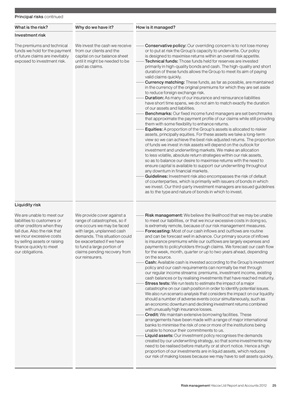
Principal risks continued
What is the risk? Why do we have it? How is it managed?
Investment risk
The premiums and technical We invest the cash we receive Conservative policy: Our overriding concern is to not lose money
funds we hold for the payment from our clients and the or to put at risk the Group’s capacity to underwrite. Our policy
of future claims are inevitably capital on our balance sheet is designed to maximise returns within an overall risk appetite.
exposed to investment risk. until it might be needed to be Technical funds: Those funds held for reserves are invested
paid as claims. primarily in high-quality bonds and cash. The high-quality and short
duration of these funds allows the Group to meet its aim of paying
valid claims quickly.
Currency matching: These funds, as far as possible, are maintained
in the currency of the original premiums for which they are set aside
to reduce foreign exchange risk.
Duration: As many of our insurance and reinsurance liabilities
have short time spans, we do not aim to match exactly the duration
of our assets and liabilities.
Benchmarks: Our fixed income fund managers are set benchmarks
that approximate the payment profile of our claims while still providing
them with some flexibility to enhance returns.
Equities: A proportion of the Group’s assets is allocated to riskier
assets, principally equities. For these assets we take a long-term
view so we can achieve the best risk-adjusted returns. The proportion
of funds we invest in risk assets will depend on the outlook for
investment and underwriting markets. We make an allocation
to less volatile, absolute return strategies within our risk assets,
so as to balance our desire to maximise returns with the need to
ensure capital is available to support our underwriting throughout
any downturn in financial markets.
Guidelines: Investment risk also encompasses the risk of default
of counterparties, which is primarily with issuers of bonds in which
we invest. Our third-party investment managers are issued guidelines
as to the type and nature of bonds in which to invest.
Liquidity risk
We are unable to meet our We provide cover against a Risk management: We believe the likelihood that we may be unable
liabilities to customers or range of catastrophes, so if to meet our liabilities, or that we incur excessive costs in doing so,
other creditors when they one occurs we may be faced is extremely remote, because of our risk management measures.
fall due. Also the risk that with large, unplanned cash Forecasting: Most of our cash inflows and outflows are routine
we incur excessive costs demands. This situation could and can be forecast well in advance. Our primary source of inflows
by selling assets or raising be exacerbated if we have is insurance premiums while our outflows are largely expenses and
finance quickly to meet to fund a large portion of payments to policyholders through claims. We forecast our cash flow
our obligations. claims pending recovery from for the week, month, quarter or up to two years ahead, depending
our reinsurers. on the source.
Cash: Available cash is invested according to the Group’s investment
policy and our cash requirements can normally be met through
our regular income streams: premiums, investment income, existing
cash balances or by realising investments that have reached maturity.
Stress tests: We run tests to estimate the impact of a major
catastrophe on our cash position in order to identify potential issues.
We also run scenario analysis that considers the impact on our liquidity
should a number of adverse events occur simultaneously, such as
an economic downturn and declining investment returns combined
with unusually high insurance losses.
Credit: We maintain extensive borrowing facilities. These
arrangements have been made with a range of major international
banks to minimise the risk of one or more of the institutions being
unable to honour their commitments to us.
Liquid assets: Our investment policy recognises the demands
created by our underwriting strategy, so that some investments may
need to be realised before maturity or at short notice. Hence a high
proportion of our investments are in liquid assets, which reduces
our risk of making losses because we may have to sell assets quickly.
Risk management Hiscox Ltd Report and Accounts 2012 25